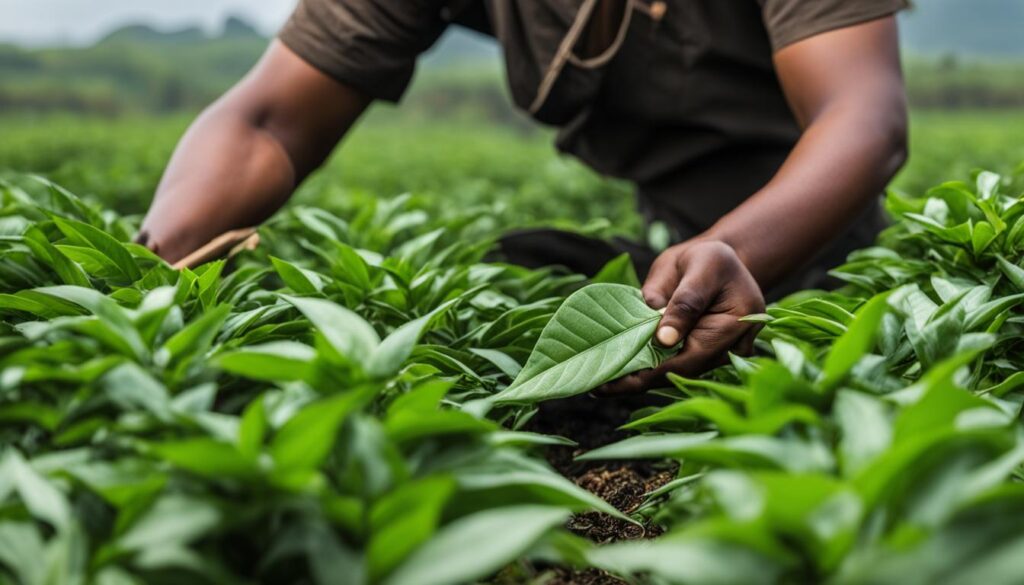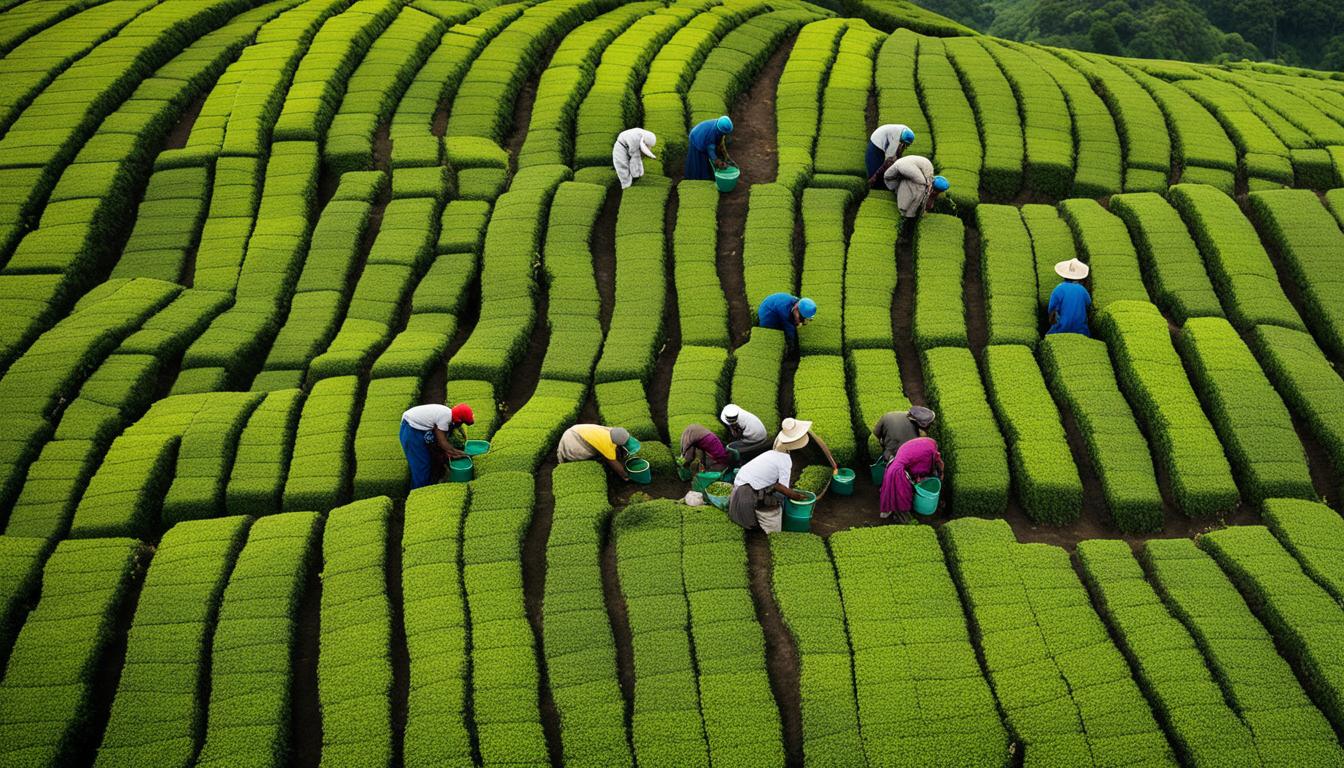Welcome to our comprehensive guide on tea leaf plucking techniques! Whether you’re a tea enthusiast or just curious about the fascinating world of tea production, this article will explore the traditional and modern methods used to pluck tea leaves.
Plucking tea leaves is an art that requires precision and knowledge. It involves carefully selecting the freshest leaves from tea trees, ensuring the highest quality and flavor in each cup of tea.
There are two main methods of plucking tea: hand plucking and machine plucking. Hand plucking, a traditional technique, involves delicately breaking off the tea bud or a bud with one or two leaves using the index finger and thumb. This method may be low in efficiency, but it is ideal for producing high-quality teas that boast exquisite flavors and aromas.
On the other hand, machine plucking utilizes advanced machinery to harvest tea leaves. This method significantly improves efficiency and reduces labor costs, making it suitable for producing more affordable teas. However, the flavor profile of machine-plucked teas may differ from their hand-plucked counterparts.
It’s important to note that tea leaf plucking methods can also vary by region. Different tea-growing regions have their own unique techniques and traditions, resulting in diverse flavors and characteristics.
Key Takeaways:
- Tea leaf plucking involves picking fresh leaves from tea trees.
- Hand plucking is a traditional method that offers high-quality results.
- Machine plucking improves efficiency but is better suited for cheaper teas.
- Tea leaf plucking methods can differ by region, contributing to varying flavors.
- Understanding these techniques helps appreciate the art and culture of tea production.
Plucking Young Tea Leaves Techniques
Plucking young tea leaves is a crucial aspect of tea production, ensuring the delicate flavor and aroma that tea enthusiasts crave. To achieve this, tea pluckers employ various techniques and strategies to maximize efficiency and quality.
One commonly used strategy is two-handed plucking, where pluckers use both hands to simultaneously break off the bud and leaves. This method allows for faster and more precise plucking, ensuring that only the youngest and most tender leaves are harvested. Additionally, some tea pluckers utilize small iron scrapers or picking pliers to improve their grip and speed during plucking.
Tea pluckers use two-handed plucking and tools like small iron scrapers or picking pliers to improve efficiency and maximize the quality of plucked tea leaves.
Tea plucking efficiency can also be enhanced through proper training and techniques. Experienced pluckers are adept at identifying the optimal time to pluck the young leaves, ensuring the best quality output. They understand the importance of gentle handling and swift plucking to minimize damage to the leaves, preserving their delicate characteristics.
Overall, the techniques used to pluck young tea leaves are essential for producing high-quality tea. By employing strategies such as two-handed plucking and utilizing appropriate tools, tea pluckers can enhance efficiency and maximize the flavor and aroma of the final product.
Impact of Plucking Technique on Tea Quality
When it comes to tea production, the plucking technique used can have a significant impact on the overall quality of the tea. Hand plucking, a traditional method, is often favored for high-quality teas as it allows for the selection of only the freshest and most desirable parts of the tea plant. The delicate touch of hand plucking ensures that only the bud and one or two leaves are harvested, resulting in a more refined and nuanced flavor profile. This method requires a skilled hand and is typically practiced by experienced tea pluckers who have a deep understanding of the intricacies of tea leaves.
On the other hand, machine plucking, although more efficient and cost-effective, is better suited for producing cheaper teas. Machines are used to harvest the tea leaves, which can result in a less refined flavor and aroma. The mechanical nature of machine plucking may lead to the inclusion of older or damaged leaves, which can negatively impact the overall quality of the tea. However, it is important to note that machine plucking can still be done with precision and careful control to yield satisfactory results, especially when the tea being produced is not intended for high-end markets.
Another factor to consider in tea production is the seasonal variations in tea plucking. Different seasons can yield variations in flavor and aroma due to changing environmental conditions and the growth stages of the tea plant. The spring harvest, also known as the “first flush,” is particularly sought after for its nutrient-rich leaves and delicate flavor. The unique characteristics of teas harvested during different seasons provide tea connoisseurs with a diverse range of options to explore and enjoy.
Ultimately, the plucking technique used and the timing of the harvest are essential factors in the quality of tea. Hand plucking allows for meticulous selection, resulting in high-quality teas with distinct flavors. Machine plucking, while more efficient, is better suited for producing teas at a more affordable price point. Furthermore, understanding the seasonal variations in tea plucking gives tea producers the opportunity to create teas with unique flavor profiles that cater to different preferences. By carefully considering these factors, tea producers can ensure that they deliver teas of the highest quality to tea enthusiasts around the world.

Tea Garden Plucking Schedules and Ergonomics
Tea gardens follow specific plucking schedules to ensure that tea is harvested at the optimal time. These schedules vary based on the season and the type of tea being produced. By adhering to these schedules, tea producers can maximize the flavor and quality of their teas.
Tea leaf plucking ergonomics is also a crucial consideration in tea production. Tea pluckers spend long hours in the fields, and it is important to prioritize their comfort and well-being. Adequate training, ergonomic tools, and proper techniques can help prevent strain and injury, ensuring a healthier and more efficient workforce.
Tea Garden Plucking Schedules
Tea garden plucking schedules are typically determined by factors such as weather conditions, plant growth, and the desired flavor profile of the tea being produced. For example, the first flush, or spring harvest, is known for its delicate flavor and is eagerly anticipated by tea enthusiasts. Plucking schedules for the first flush usually start early in the morning to capture the fresh morning dew and maximize the nutrient content in the tea leaves.
On the other hand, the second flush, which occurs later in the year, produces teas with a richer flavor and fuller body. The plucking schedules for the second flush may vary depending on the specific tea garden and the desired flavor characteristics. Tea producers carefully monitor the growth of the tea plants to determine the optimal time for plucking, ensuring that the leaves are at their peak flavor and quality.
Tea garden plucking schedules are not only important for achieving the desired flavor profiles but also for managing the workload and ensuring the efficiency of tea production. By planning plucking schedules ahead of time, tea producers can allocate resources effectively and optimize the use of labor. This ultimately contributes to the overall productivity and success of tea gardens.
Tea Leaf Plucking Ergonomics
Ergonomics plays a crucial role in tea leaf plucking. Tea pluckers need to adopt proper posture and use ergonomic tools to minimize the risk of strain and injury. Using tools such as comfortable plucking baskets, shears, or even modified gloves can help reduce the physical impact of tea plucking.
Periodic breaks and rest periods are also important to allow tea pluckers to rest and recharge. Tea gardens often provide designated resting areas or facilities where workers can take breaks and enjoy their meals. These breaks not only contribute to the health and well-being of the tea pluckers but also help maintain their productivity and concentration throughout the day.
Overall, tea garden plucking schedules and ergonomics go hand in hand in ensuring the production of high-quality teas. By carefully planning plucking schedules and prioritizing tea pluckers’ ergonomics, tea gardens can thrive and continue to produce teas that delight tea enthusiasts around the world.
Conclusion
In conclusion, tea leaf plucking techniques are essential in determining the quality, flavor, and aroma of tea. Whether it’s traditional hand plucking or modern machine plucking, each method has its advantages depending on the type of tea being produced. However, to ensure the best results, proper training is crucial for tea leaf pluckers.
Tea leaf plucking training allows pluckers to master the art of hand plucking, ensuring that only the freshest and most desirable parts of the tea plant are selected. This attention to detail contributes to the high-quality teas loved by tea enthusiasts all over the world.
Additionally, traditional tea leaf plucking ceremonies hold a special place in tea culture. These ceremonies preserve the rich history and traditions associated with tea, emphasizing the importance of mindfulness and appreciation for the tea-making process.
As we continue to explore and innovate in the world of tea, let us not forget the significance of proper training and the beauty of traditional ceremonies in promoting a deeper connection to this beloved beverage.
FAQ
What is plucking tea?
Plucking tea is the process of picking fresh tea leaves from the tea tree.
What are the two main methods of plucking tea?
The two main methods of plucking tea are hand plucking and machine plucking.
How does hand plucking work?
Hand plucking involves breaking off the tea bud or tea bud with one or two leaves using the index finger and thumb.
What is machine plucking?
Machine plucking involves using machines to harvest tea leaves.
which method is suitable for making high-quality teas?
Hand plucking is suitable for making high-quality teas.
Which method is best for making cheaper teas?
Machine plucking is best for making cheaper teas.
Is tea leaf plucking different in different regions?
Yes, different regions may have their own unique tea leaf plucking methods.





